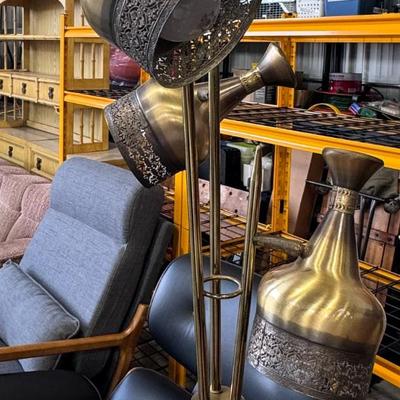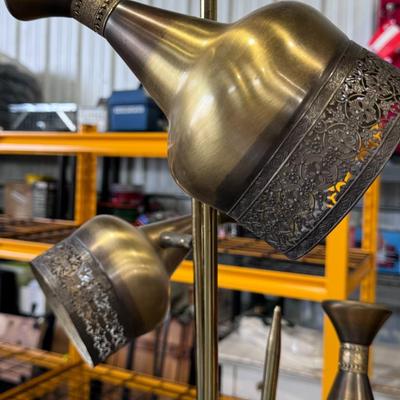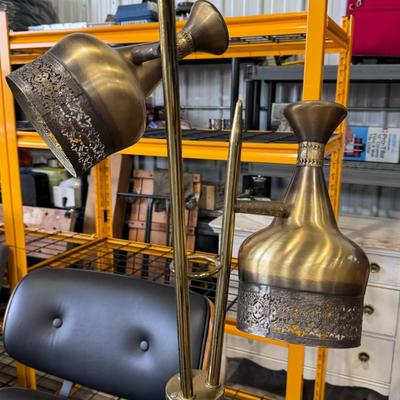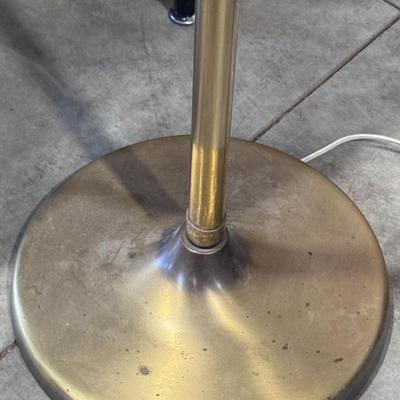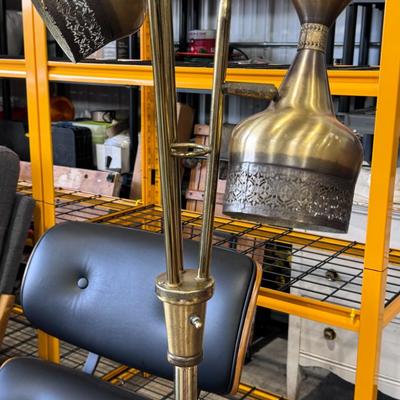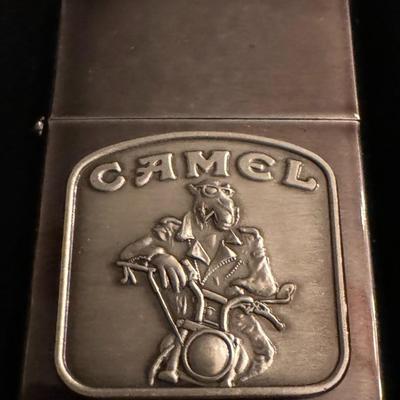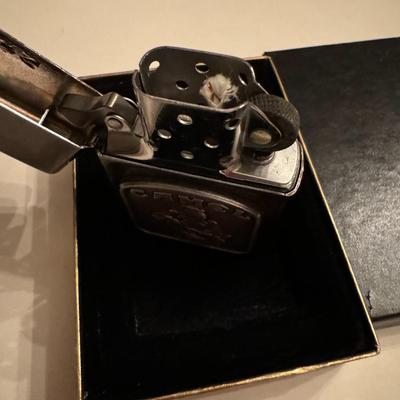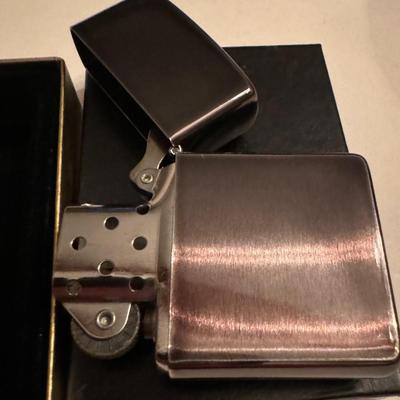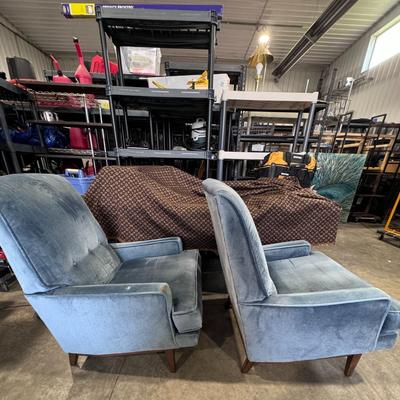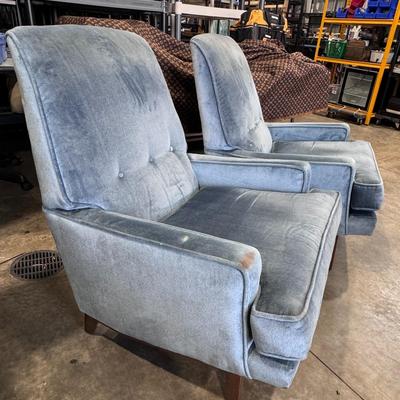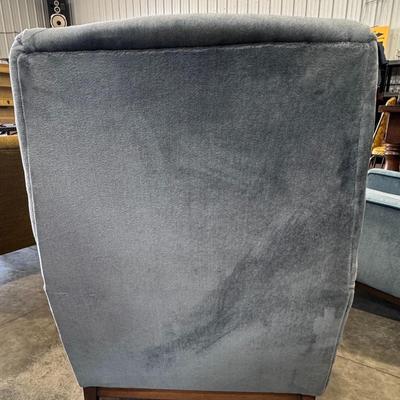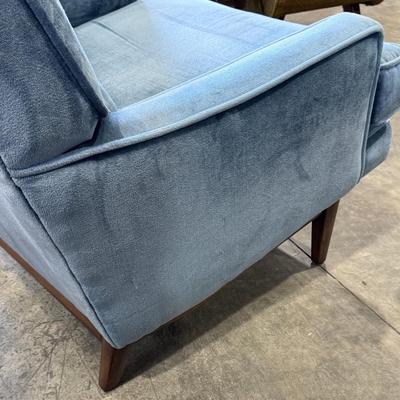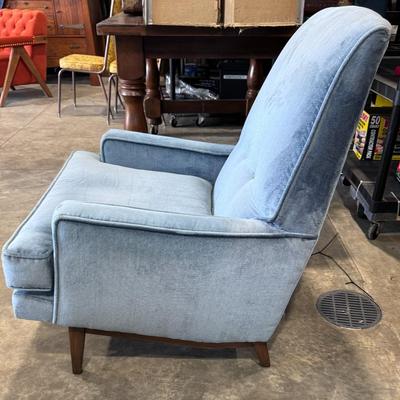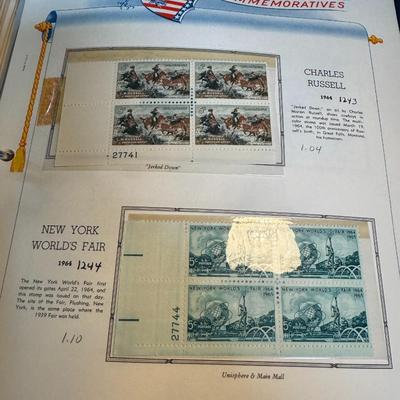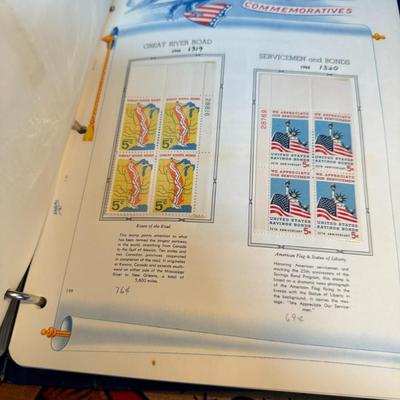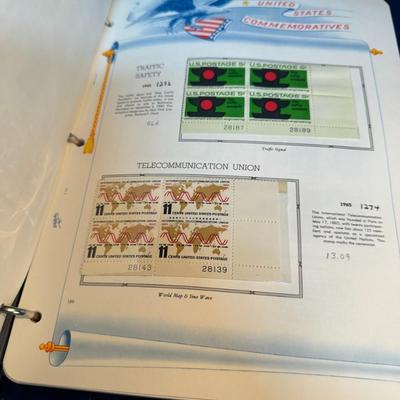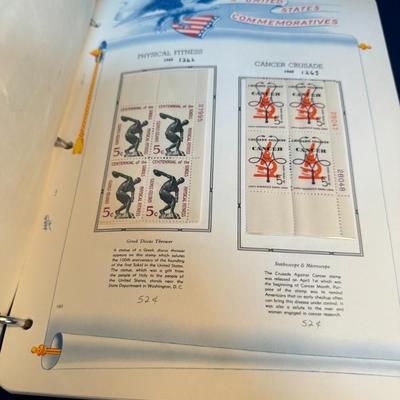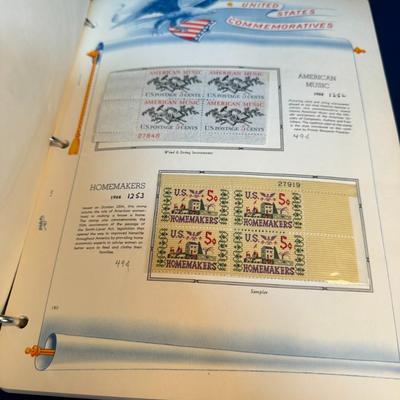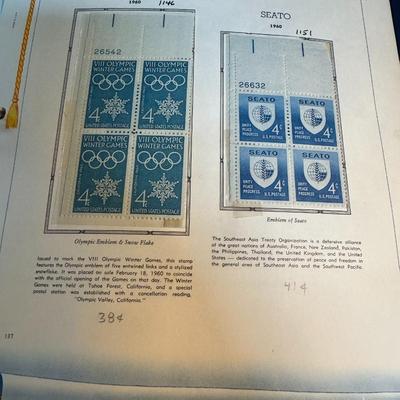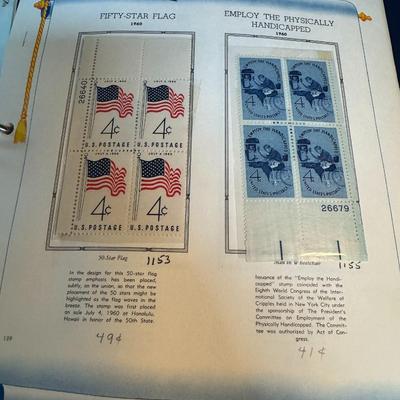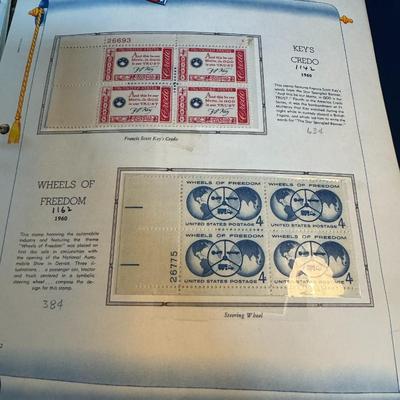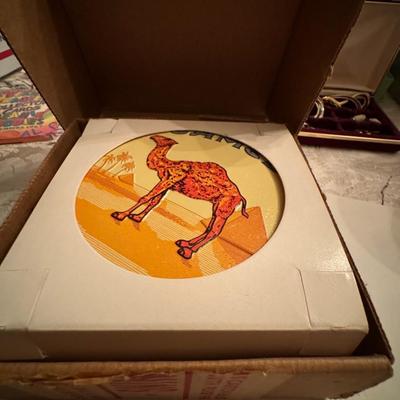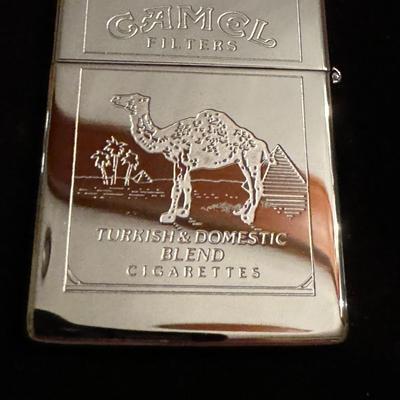-
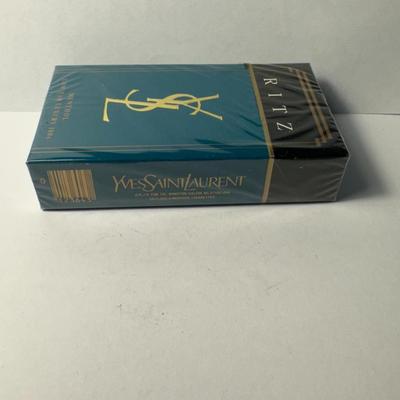
Vintage pack of Ritz Menthol cigarettes, a brand that was introduced in the mid-1980s by R.J. Reynolds Tobacco Company in collaboration with the renowned fashion house Yves Saint Laurent (YSL). Here's more information about this product: Designer Collaboration: Ritz cigarettes were notable for being marketed as the first "luxury-class" cigarette created in association with a major fashion designer, Yves Saint Laurent. Target Audience: The brand was specifically aimed at "fashion-conscious female smokers" in their 20s and 30s. Design Elements: The packaging, as seen in the image, features a distinctive design with the YSL monogram prominently displayed. The menthol version (like the one pictured) came in a deep aqua color scheme. Marketing & Controversy: Ads for Ritz were photographed by famed fashion photographer Helmut Newton and aimed to evoke a sense of "romance, mystery and intrigue of a spirited, opulent lifestyle". The collaboration between a tobacco company and a high-fashion brand sparked some controversy at the time. Availability: While the brand was test-marketed in several locations in the US, including Atlanta, Memphis, Oklahoma City, and Washington State, it was later also sold in other countries like Portugal, Brazil, Sweden, Finland, and Paraguay 301 / 1369 -
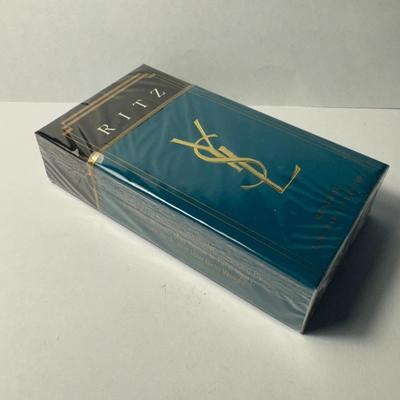
Vintage pack of Ritz Menthol cigarettes, a brand that was introduced in the mid-1980s by R.J. Reynolds Tobacco Company in collaboration with the renowned fashion house Yves Saint Laurent (YSL). Here's more information about this product: Designer Collaboration: Ritz cigarettes were notable for being marketed as the first "luxury-class" cigarette created in association with a major fashion designer, Yves Saint Laurent. Target Audience: The brand was specifically aimed at "fashion-conscious female smokers" in their 20s and 30s. Design Elements: The packaging, as seen in the image, features a distinctive design with the YSL monogram prominently displayed. The menthol version (like the one pictured) came in a deep aqua color scheme. Marketing & Controversy: Ads for Ritz were photographed by famed fashion photographer Helmut Newton and aimed to evoke a sense of "romance, mystery and intrigue of a spirited, opulent lifestyle". The collaboration between a tobacco company and a high-fashion brand sparked some controversy at the time. Availability: While the brand was test-marketed in several locations in the US, including Atlanta, Memphis, Oklahoma City, and Washington State, it was later also sold in other countries like Portugal, Brazil, Sweden, Finland, and Paraguay 302 / 1369 -
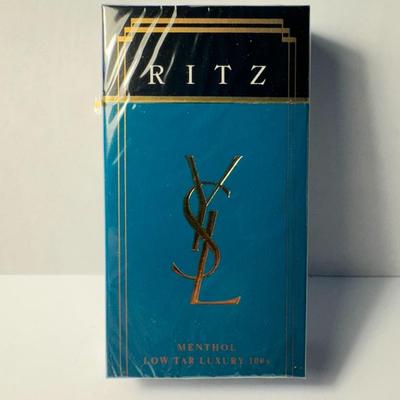
Vintage pack of Ritz Menthol cigarettes, a brand that was introduced in the mid-1980s by R.J. Reynolds Tobacco Company in collaboration with the renowned fashion house Yves Saint Laurent (YSL). Here's more information about this product: Designer Collaboration: Ritz cigarettes were notable for being marketed as the first "luxury-class" cigarette created in association with a major fashion designer, Yves Saint Laurent. Target Audience: The brand was specifically aimed at "fashion-conscious female smokers" in their 20s and 30s. Design Elements: The packaging, as seen in the image, features a distinctive design with the YSL monogram prominently displayed. The menthol version (like the one pictured) came in a deep aqua color scheme. Marketing & Controversy: Ads for Ritz were photographed by famed fashion photographer Helmut Newton and aimed to evoke a sense of "romance, mystery and intrigue of a spirited, opulent lifestyle". The collaboration between a tobacco company and a high-fashion brand sparked some controversy at the time. Availability: While the brand was test-marketed in several locations in the US, including Atlanta, Memphis, Oklahoma City, and Washington State, it was later also sold in other countries like Portugal, Brazil, Sweden, Finland, and Paraguay 303 / 1369 -
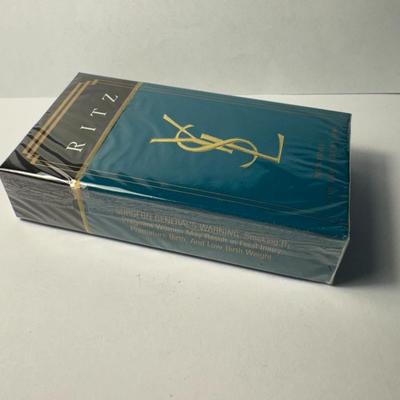
Vintage pack of Ritz Menthol cigarettes, a brand that was introduced in the mid-1980s by R.J. Reynolds Tobacco Company in collaboration with the renowned fashion house Yves Saint Laurent (YSL). Here's more information about this product: Designer Collaboration: Ritz cigarettes were notable for being marketed as the first "luxury-class" cigarette created in association with a major fashion designer, Yves Saint Laurent. Target Audience: The brand was specifically aimed at "fashion-conscious female smokers" in their 20s and 30s. Design Elements: The packaging, as seen in the image, features a distinctive design with the YSL monogram prominently displayed. The menthol version (like the one pictured) came in a deep aqua color scheme. Marketing & Controversy: Ads for Ritz were photographed by famed fashion photographer Helmut Newton and aimed to evoke a sense of "romance, mystery and intrigue of a spirited, opulent lifestyle". The collaboration between a tobacco company and a high-fashion brand sparked some controversy at the time. Availability: While the brand was test-marketed in several locations in the US, including Atlanta, Memphis, Oklahoma City, and Washington State, it was later also sold in other countries like Portugal, Brazil, Sweden, Finland, and Paraguay 304 / 1369 -
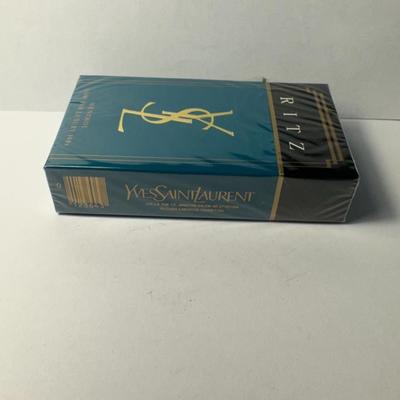
Vintage pack of Ritz Menthol cigarettes, a brand that was introduced in the mid-1980s by R.J. Reynolds Tobacco Company in collaboration with the renowned fashion house Yves Saint Laurent (YSL). Here's more information about this product: Designer Collaboration: Ritz cigarettes were notable for being marketed as the first "luxury-class" cigarette created in association with a major fashion designer, Yves Saint Laurent. Target Audience: The brand was specifically aimed at "fashion-conscious female smokers" in their 20s and 30s. Design Elements: The packaging, as seen in the image, features a distinctive design with the YSL monogram prominently displayed. The menthol version (like the one pictured) came in a deep aqua color scheme. Marketing & Controversy: Ads for Ritz were photographed by famed fashion photographer Helmut Newton and aimed to evoke a sense of "romance, mystery and intrigue of a spirited, opulent lifestyle". The collaboration between a tobacco company and a high-fashion brand sparked some controversy at the time. Availability: While the brand was test-marketed in several locations in the US, including Atlanta, Memphis, Oklahoma City, and Washington State, it was later also sold in other countries like Portugal, Brazil, Sweden, Finland, and Paraguay 305 / 1369 -
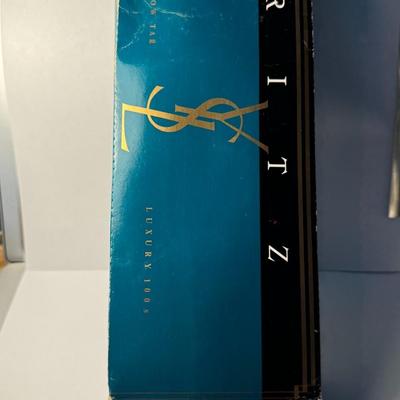
Vintage pack of Ritz Menthol cigarettes, a brand that was introduced in the mid-1980s by R.J. Reynolds Tobacco Company in collaboration with the renowned fashion house Yves Saint Laurent (YSL). Here's more information about this product: Designer Collaboration: Ritz cigarettes were notable for being marketed as the first "luxury-class" cigarette created in association with a major fashion designer, Yves Saint Laurent. Target Audience: The brand was specifically aimed at "fashion-conscious female smokers" in their 20s and 30s. Design Elements: The packaging, as seen in the image, features a distinctive design with the YSL monogram prominently displayed. The menthol version (like the one pictured) came in a deep aqua color scheme. Marketing & Controversy: Ads for Ritz were photographed by famed fashion photographer Helmut Newton and aimed to evoke a sense of "romance, mystery and intrigue of a spirited, opulent lifestyle". The collaboration between a tobacco company and a high-fashion brand sparked some controversy at the time. Availability: While the brand was test-marketed in several locations in the US, including Atlanta, Memphis, Oklahoma City, and Washington State, it was later also sold in other countries like Portugal, Brazil, Sweden, Finland, and Paraguay 306 / 1369 -
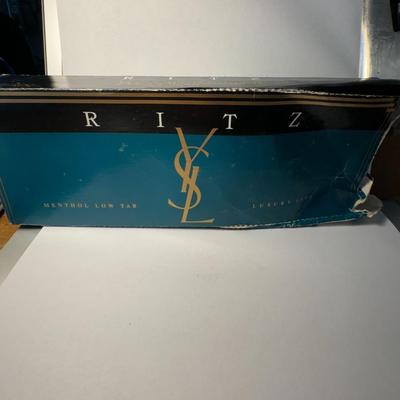
Vintage pack of Ritz Menthol cigarettes, a brand that was introduced in the mid-1980s by R.J. Reynolds Tobacco Company in collaboration with the renowned fashion house Yves Saint Laurent (YSL). Here's more information about this product: Designer Collaboration: Ritz cigarettes were notable for being marketed as the first "luxury-class" cigarette created in association with a major fashion designer, Yves Saint Laurent. Target Audience: The brand was specifically aimed at "fashion-conscious female smokers" in their 20s and 30s. Design Elements: The packaging, as seen in the image, features a distinctive design with the YSL monogram prominently displayed. The menthol version (like the one pictured) came in a deep aqua color scheme. Marketing & Controversy: Ads for Ritz were photographed by famed fashion photographer Helmut Newton and aimed to evoke a sense of "romance, mystery and intrigue of a spirited, opulent lifestyle". The collaboration between a tobacco company and a high-fashion brand sparked some controversy at the time. Availability: While the brand was test-marketed in several locations in the US, including Atlanta, Memphis, Oklahoma City, and Washington State, it was later also sold in other countries like Portugal, Brazil, Sweden, Finland, and Paraguay 307 / 1369 -
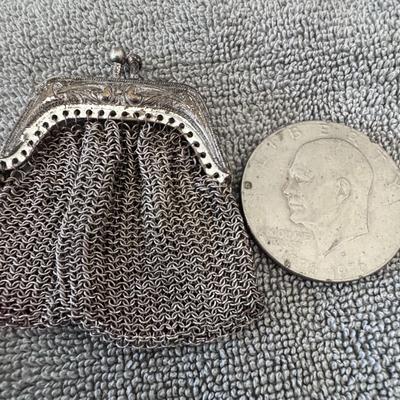
Vintage Silver Mesh Coin Purse: This appears to be an antique or vintage metal mesh purse, likely intended for carrying coins or small essentials. The frame features decorative engraving, suggesting an Art Nouveau or Victorian era design. Similar purses were often crafted from sterling silver or German silver (an alloy). They were a popular accessory in the late 19th and early 20th centuries. 308 / 1369 -
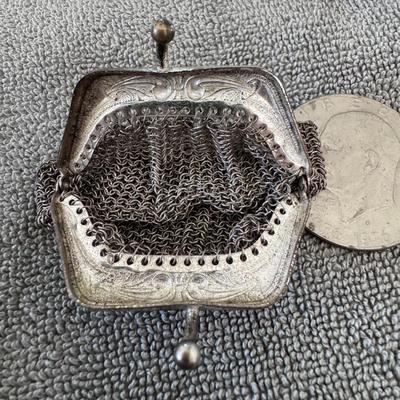
Vintage Silver Mesh Coin Purse: This appears to be an antique or vintage metal mesh purse, likely intended for carrying coins or small essentials. The frame features decorative engraving, suggesting an Art Nouveau or Victorian era design. Similar purses were often crafted from sterling silver or German silver (an alloy). They were a popular accessory in the late 19th and early 20th centuries. 309 / 1369 -
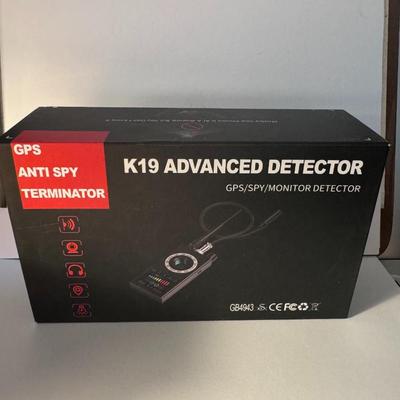
K19 Advanced Detector, often marketed as an Anti Spy Detector, Hidden Camera Detector, Bug Detector, or GPS/Spy/Monitor Detector. It is designed to help detect various hidden surveillance devices and protect personal privacy. Key features and functionalities of the K19 Advanced Detector include: Multi-functional Detection: It can detect hidden cameras (both wired and wireless), bugging devices, GPS trackers, and other monitoring equipment. Multiple Detection Modes: It utilizes various technologies such as RF wireless signal detection, magnetic field signal detection, and infrared detection for hidden cameras with night vision capabilities. Ease of Use: The device is designed for user-friendliness with features like adjustable sensitivity, clear signal strength indicators (often an LCD display), and options for audible or vibration alerts. 310 / 1369 -
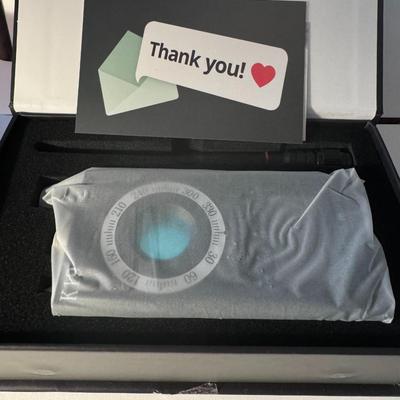
K19 Advanced Detector, often marketed as an Anti Spy Detector, Hidden Camera Detector, Bug Detector, or GPS/Spy/Monitor Detector. It is designed to help detect various hidden surveillance devices and protect personal privacy. Key features and functionalities of the K19 Advanced Detector include: Multi-functional Detection: It can detect hidden cameras (both wired and wireless), bugging devices, GPS trackers, and other monitoring equipment. Multiple Detection Modes: It utilizes various technologies such as RF wireless signal detection, magnetic field signal detection, and infrared detection for hidden cameras with night vision capabilities. Ease of Use: The device is designed for user-friendliness with features like adjustable sensitivity, clear signal strength indicators (often an LCD display), and options for audible or vibration alerts. 311 / 1369 -
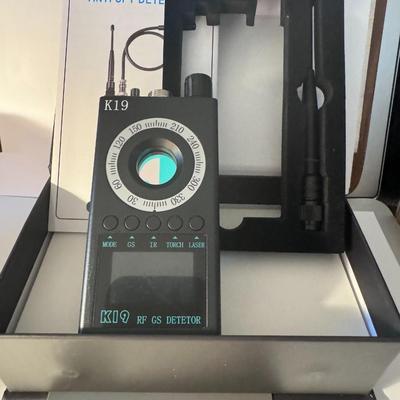
K19 Advanced Detector, often marketed as an Anti Spy Detector, Hidden Camera Detector, Bug Detector, or GPS/Spy/Monitor Detector. It is designed to help detect various hidden surveillance devices and protect personal privacy. Key features and functionalities of the K19 Advanced Detector include: Multi-functional Detection: It can detect hidden cameras (both wired and wireless), bugging devices, GPS trackers, and other monitoring equipment. Multiple Detection Modes: It utilizes various technologies such as RF wireless signal detection, magnetic field signal detection, and infrared detection for hidden cameras with night vision capabilities. Ease of Use: The device is designed for user-friendliness with features like adjustable sensitivity, clear signal strength indicators (often an LCD display), and options for audible or vibration alerts. 312 / 1369 -
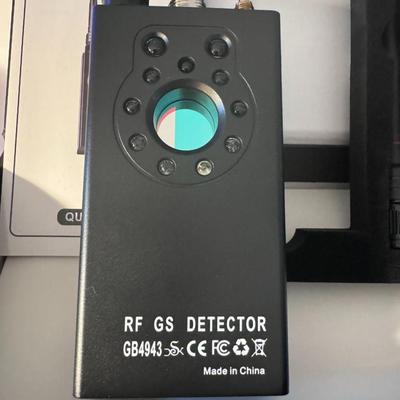
K19 Advanced Detector, often marketed as an Anti Spy Detector, Hidden Camera Detector, Bug Detector, or GPS/Spy/Monitor Detector. It is designed to help detect various hidden surveillance devices and protect personal privacy. Key features and functionalities of the K19 Advanced Detector include: Multi-functional Detection: It can detect hidden cameras (both wired and wireless), bugging devices, GPS trackers, and other monitoring equipment. Multiple Detection Modes: It utilizes various technologies such as RF wireless signal detection, magnetic field signal detection, and infrared detection for hidden cameras with night vision capabilities. Ease of Use: The device is designed for user-friendliness with features like adjustable sensitivity, clear signal strength indicators (often an LCD display), and options for audible or vibration alerts. 313 / 1369 -
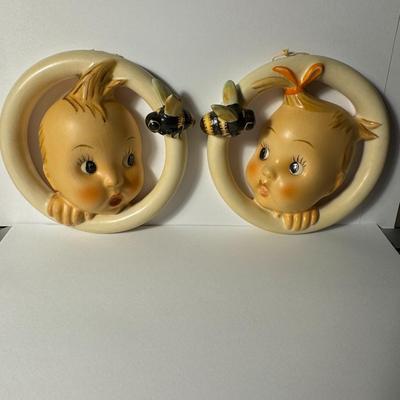
Goebel Hummel Ba-Bee Ring wall plaques. These wall plaques are part of the original Hummel Collection first released in 1935. The plaques are made of porcelain and feature a baby boy and girl looking at a bumblebee through a ring. The boy has dark blonde hair and hazel eyes, while the girl has an inquisitive expression. These plaques were designed by master sculptor Reinhold Unger. They typically measure around 5 inches in diameter. In excellent condition 314 / 1369 -
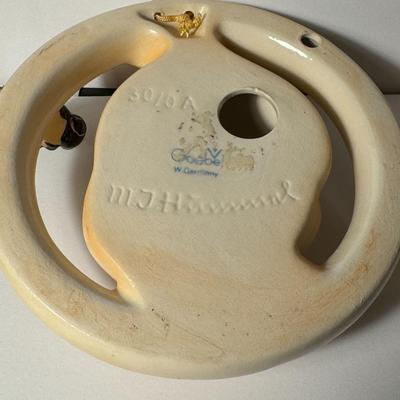
Goebel Hummel Ba-Bee Ring wall plaques. These wall plaques are part of the original Hummel Collection first released in 1935. The plaques are made of porcelain and feature a baby boy and girl looking at a bumblebee through a ring. The boy has dark blonde hair and hazel eyes, while the girl has an inquisitive expression. These plaques were designed by master sculptor Reinhold Unger. They typically measure around 5 inches in diameter. In excellent condition 315 / 1369 -
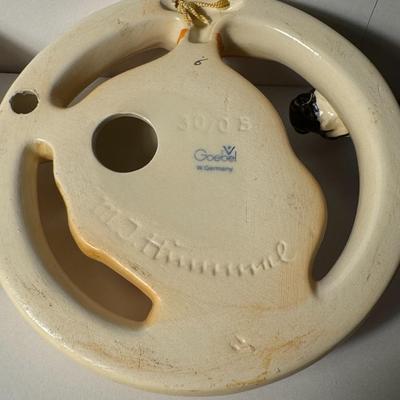
Goebel Hummel Ba-Bee Ring wall plaques. These wall plaques are part of the original Hummel Collection first released in 1935. The plaques are made of porcelain and feature a baby boy and girl looking at a bumblebee through a ring. The boy has dark blonde hair and hazel eyes, while the girl has an inquisitive expression. These plaques were designed by master sculptor Reinhold Unger. They typically measure around 5 inches in diameter. In excellent condition 316 / 1369 -
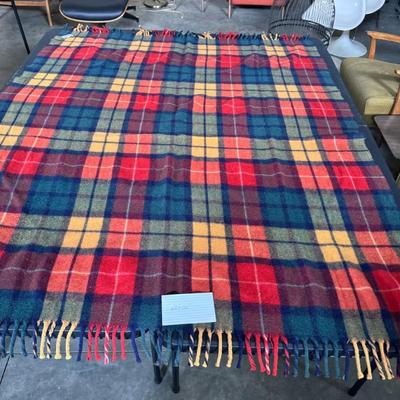
"Ottawa Valley blanket." These blankets are notable for their history and material: Origin and History: "Ottawa Valley Woollens" was a label for blankets produced in wool mills located in towns like Carleton Place and Almonte in the Ottawa Valley. This industry experienced its peak in the late 1940s, with most mills closing by the 1950s due to rising costs. Material: These blankets are typically made from 100% pure wool. Appearance: They are commonly found in plaid patterns featuring various color combinations, such as the red, green, blue, and yellow visible in your image. Use: Vintage Ottawa Valley wool blankets like yours are often used as throw blankets for warmth and decor in homes, cottages, or for outdoor activities like camping. 322 / 1369 -
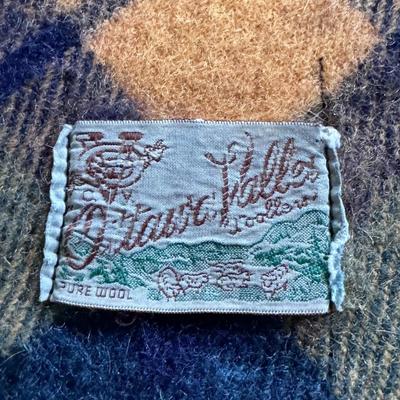
"Ottawa Valley blanket." These blankets are notable for their history and material: Origin and History: "Ottawa Valley Woollens" was a label for blankets produced in wool mills located in towns like Carleton Place and Almonte in the Ottawa Valley. This industry experienced its peak in the late 1940s, with most mills closing by the 1950s due to rising costs. Material: These blankets are typically made from 100% pure wool. Appearance: They are commonly found in plaid patterns featuring various color combinations, such as the red, green, blue, and yellow visible in your image. Use: Vintage Ottawa Valley wool blankets like yours are often used as throw blankets for warmth and decor in homes, cottages, or for outdoor activities like camping. 323 / 1369 -
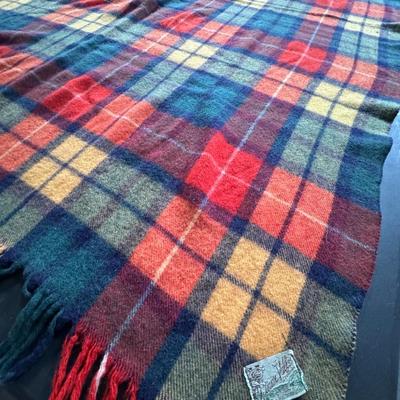
"Ottawa Valley blanket." These blankets are notable for their history and material: Origin and History: "Ottawa Valley Woollens" was a label for blankets produced in wool mills located in towns like Carleton Place and Almonte in the Ottawa Valley. This industry experienced its peak in the late 1940s, with most mills closing by the 1950s due to rising costs. Material: These blankets are typically made from 100% pure wool. Appearance: They are commonly found in plaid patterns featuring various color combinations, such as the red, green, blue, and yellow visible in your image. Use: Vintage Ottawa Valley wool blankets like yours are often used as throw blankets for warmth and decor in homes, cottages, or for outdoor activities like camping. 324 / 1369 -
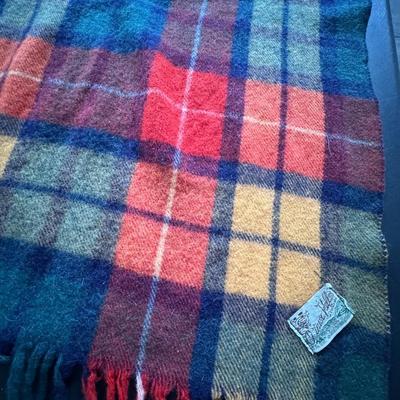
"Ottawa Valley blanket." These blankets are notable for their history and material: Origin and History: "Ottawa Valley Woollens" was a label for blankets produced in wool mills located in towns like Carleton Place and Almonte in the Ottawa Valley. This industry experienced its peak in the late 1940s, with most mills closing by the 1950s due to rising costs. Material: These blankets are typically made from 100% pure wool. Appearance: They are commonly found in plaid patterns featuring various color combinations, such as the red, green, blue, and yellow visible in your image. Use: Vintage Ottawa Valley wool blankets like yours are often used as throw blankets for warmth and decor in homes, cottages, or for outdoor activities like camping. 325 / 1369 -

"Ottawa Valley blanket." These blankets are notable for their history and material: Origin and History: "Ottawa Valley Woollens" was a label for blankets produced in wool mills located in towns like Carleton Place and Almonte in the Ottawa Valley. This industry experienced its peak in the late 1940s, with most mills closing by the 1950s due to rising costs. Material: These blankets are typically made from 100% pure wool. Appearance: They are commonly found in plaid patterns featuring various color combinations, such as the red, green, blue, and yellow visible in your image. Use: Vintage Ottawa Valley wool blankets like yours are often used as throw blankets for warmth and decor in homes, cottages, or for outdoor activities like camping. 326 / 1369 -
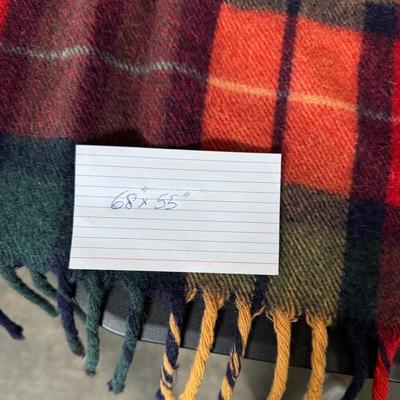
"Ottawa Valley blanket." These blankets are notable for their history and material: Origin and History: "Ottawa Valley Woollens" was a label for blankets produced in wool mills located in towns like Carleton Place and Almonte in the Ottawa Valley. This industry experienced its peak in the late 1940s, with most mills closing by the 1950s due to rising costs. Material: These blankets are typically made from 100% pure wool. Appearance: They are commonly found in plaid patterns featuring various color combinations, such as the red, green, blue, and yellow visible in your image. Use: Vintage Ottawa Valley wool blankets like yours are often used as throw blankets for warmth and decor in homes, cottages, or for outdoor activities like camping. 327 / 1369 -
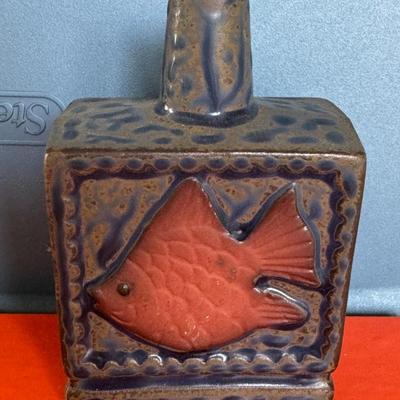
The image shows a blue and brown matte square fish vase, possibly a vintage piece made in Japan by Takahashi or Otagiri. It features a textured surface with a raised orange fish design in the center, and a unique shape that includes a smaller opening on top. The vase is in excellent condition, noting minor glaze skips due to its handmade nature. It measures approximately 4 inches high, 2.5 inches wide, and 1.5 inches deep. 328 / 1369 -
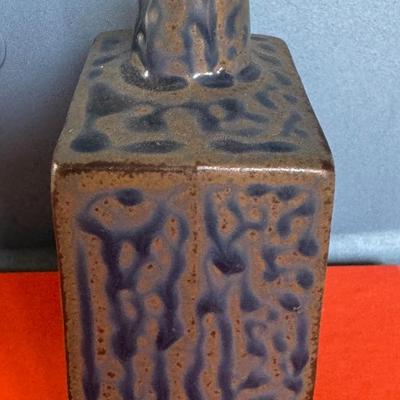
The image shows a blue and brown matte square fish vase, possibly a vintage piece made in Japan by Takahashi or Otagiri. It features a textured surface with a raised orange fish design in the center, and a unique shape that includes a smaller opening on top. The vase is in excellent condition, noting minor glaze skips due to its handmade nature. It measures approximately 4 inches high, 2.5 inches wide, and 1.5 inches deep. 329 / 1369 -
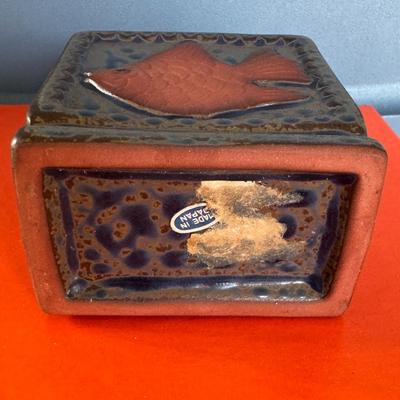
The image shows a blue and brown matte square fish vase, possibly a vintage piece made in Japan by Takahashi or Otagiri. It features a textured surface with a raised orange fish design in the center, and a unique shape that includes a smaller opening on top. The vase is in excellent condition, noting minor glaze skips due to its handmade nature. It measures approximately 4 inches high, 2.5 inches wide, and 1.5 inches deep. 330 / 1369 -
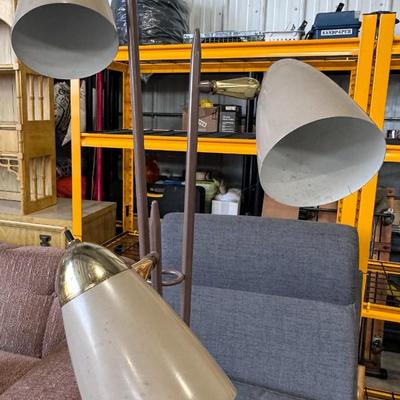
Nice 50's floor lamp, bullet shade 331 / 1369 -
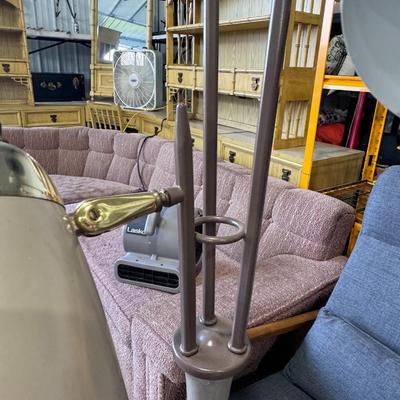
Nice 50's floor lamp, bullet shade 332 / 1369 -
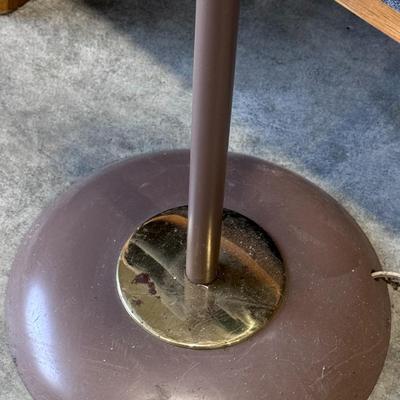
Nice 50's floor lamp, bullet shade 333 / 1369 -
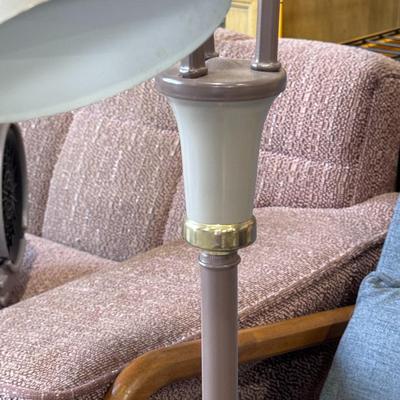
Nice 50's floor lamp, bullet shade 334 / 1369 -
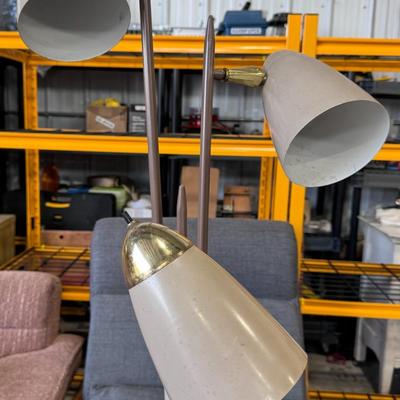
Nice 50's floor lamp, bullet shade 335 / 1369 -
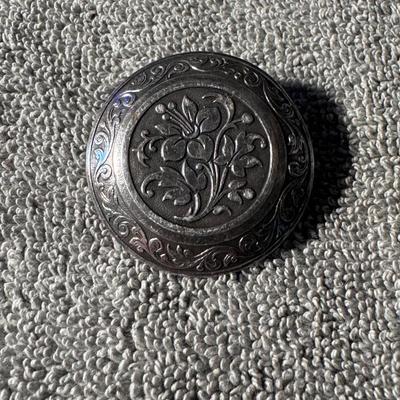
Antique Silver Mourning Brooch. Here's more information about this type of historical jewelry: Purpose: Mourning jewelry, including brooches, served as a way to commemorate and express grief for deceased loved ones, particularly popular during the Victorian era. Characteristics: These pieces often incorporated symbols of remembrance, such as memorial inscriptions, initials, or even locks of hair from the departed. Materials: Mourning brooches were frequently crafted from materials like silver, jet, or black enamel, sometimes incorporating hairwork or small portraits. Historical Context: Queen Victoria's extended mourning for Prince Albert significantly popularized mourning jewelry, making black attire and matching jewelry a widespread practice for decades following his death in 1861. 339 / 1369 -
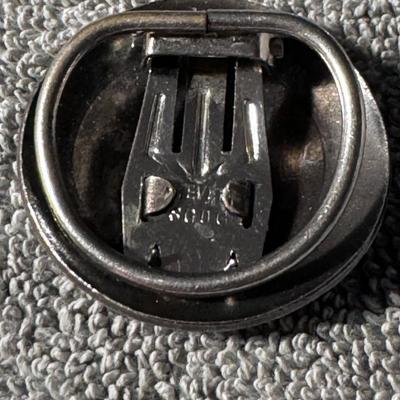
Antique Silver Mourning Brooch. Here's more information about this type of historical jewelry: Purpose: Mourning jewelry, including brooches, served as a way to commemorate and express grief for deceased loved ones, particularly popular during the Victorian era. Characteristics: These pieces often incorporated symbols of remembrance, such as memorial inscriptions, initials, or even locks of hair from the departed. Materials: Mourning brooches were frequently crafted from materials like silver, jet, or black enamel, sometimes incorporating hairwork or small portraits. Historical Context: Queen Victoria's extended mourning for Prince Albert significantly popularized mourning jewelry, making black attire and matching jewelry a widespread practice for decades following his death in 1861. 340 / 1369 -
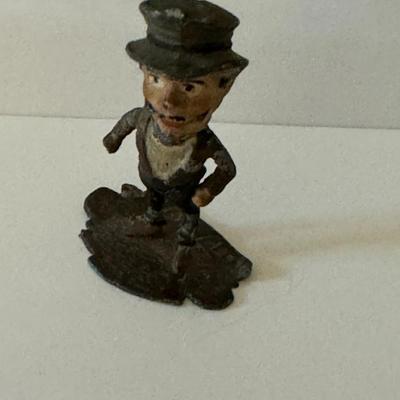
4" lead 1800's bobble head 341 / 1369 -
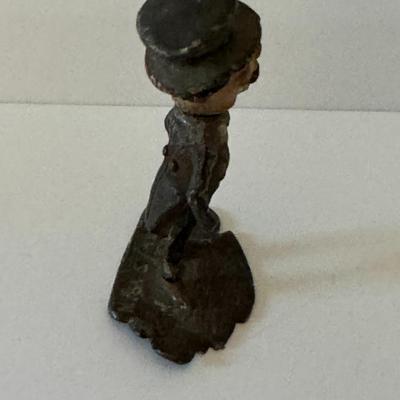
4" lead 1800's bobble head 342 / 1369 -
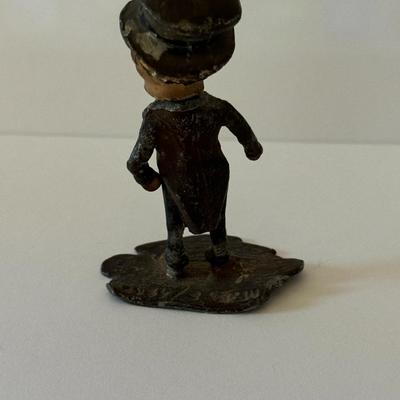
4" lead 1800's bobble head 343 / 1369 -
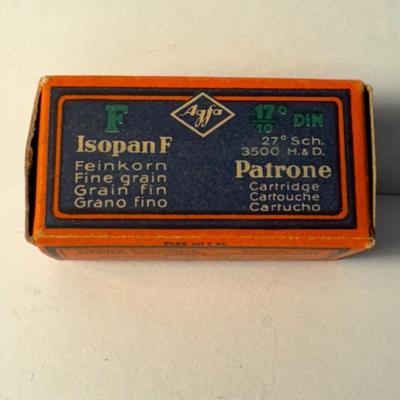
vintage box of Agfa Isopan F film, a type of black and white film produced by the German company Agfa. Here's more information about Agfa Isopan F: Type: It is a panchromatic, black and white film known for its fine grain ("Feinkorn" in German, "Fine grain" in English). Sensitivity: The box indicates a sensitivity of 17 DIN, which translates to approximately 40 ASA. Format: The film in the image appears to be for 35mm cameras, as indicated by "Patrone," "Cartridge," and "Cartouche" which refers to film cartridges for this format. Production Era: 1940's Historical Context: Agfa was a prominent manufacturer of photographic products, including cameras and film, and played a significant role in the history of photography. 344 / 1369 -
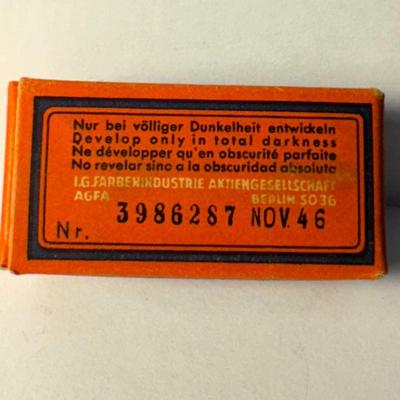
vintage box of Agfa Isopan F film, a type of black and white film produced by the German company Agfa. Here's more information about Agfa Isopan F: Type: It is a panchromatic, black and white film known for its fine grain ("Feinkorn" in German, "Fine grain" in English). Sensitivity: The box indicates a sensitivity of 17 DIN, which translates to approximately 40 ASA. Format: The film in the image appears to be for 35mm cameras, as indicated by "Patrone," "Cartridge," and "Cartouche" which refers to film cartridges for this format. Production Era: 1940's Historical Context: Agfa was a prominent manufacturer of photographic products, including cameras and film, and played a significant role in the history of photography. 345 / 1369 -
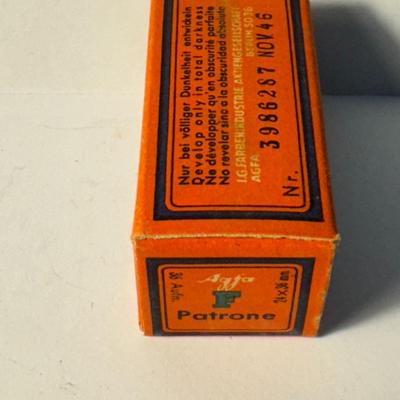
vintage box of Agfa Isopan F film, a type of black and white film produced by the German company Agfa. Here's more information about Agfa Isopan F: Type: It is a panchromatic, black and white film known for its fine grain ("Feinkorn" in German, "Fine grain" in English). Sensitivity: The box indicates a sensitivity of 17 DIN, which translates to approximately 40 ASA. Format: The film in the image appears to be for 35mm cameras, as indicated by "Patrone," "Cartridge," and "Cartouche" which refers to film cartridges for this format. Production Era: 1940's Historical Context: Agfa was a prominent manufacturer of photographic products, including cameras and film, and played a significant role in the history of photography. 346 / 1369 -
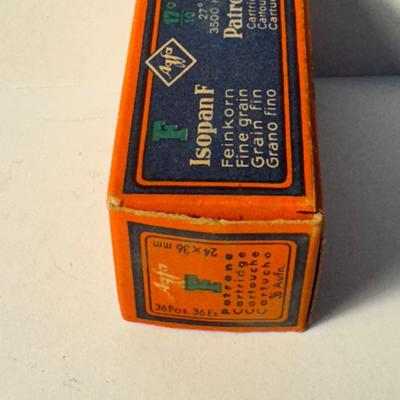
vintage box of Agfa Isopan F film, a type of black and white film produced by the German company Agfa. Here's more information about Agfa Isopan F: Type: It is a panchromatic, black and white film known for its fine grain ("Feinkorn" in German, "Fine grain" in English). Sensitivity: The box indicates a sensitivity of 17 DIN, which translates to approximately 40 ASA. Format: The film in the image appears to be for 35mm cameras, as indicated by "Patrone," "Cartridge," and "Cartouche" which refers to film cartridges for this format. Production Era: 1940's Historical Context: Agfa was a prominent manufacturer of photographic products, including cameras and film, and played a significant role in the history of photography. 347 / 1369 -
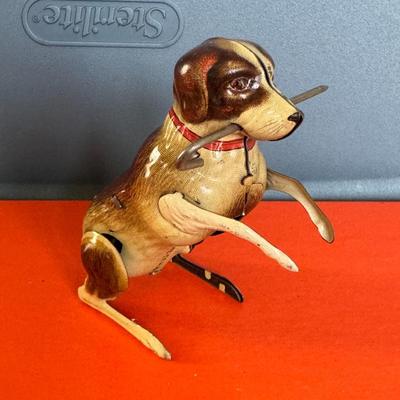
Georg Köhler Dog with Sticks Dance Figure, a rare tin toy from the 1950s. It features a jumping mechanism with a clockwork drive. The toy is approximately 75 mm long. Georg Köhler founded a game and metal goods factory in Nuremberg, Germany, in 1932, and the trademark became the letters GKN intertwined in a triangle. Initially, the company produced lithographed animal figures with clockwork mechanisms, including a frog and a bird. Later, they introduced other tin toy figures, such as the dog with a stick (as seen in the image), ducks, and squirrels. These toys were characterized by their realistic movements. This particular toy was made in the U.S. Zone of Germany, likely between 1946 and 1953. Another example of a GKN Köhler toy is a "Puss in Boots" tin litho windup from the 1940s. 353 / 1369 -
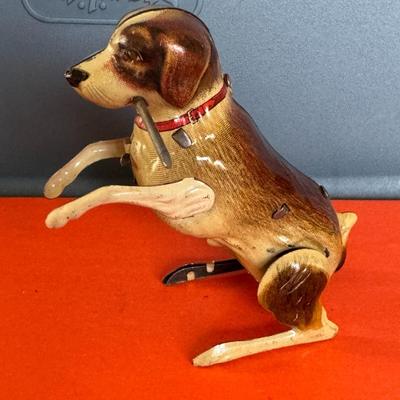
Georg Köhler Dog with Sticks Dance Figure, a rare tin toy from the 1950s. It features a jumping mechanism with a clockwork drive. The toy is approximately 75 mm long. Georg Köhler founded a game and metal goods factory in Nuremberg, Germany, in 1932, and the trademark became the letters GKN intertwined in a triangle. Initially, the company produced lithographed animal figures with clockwork mechanisms, including a frog and a bird. Later, they introduced other tin toy figures, such as the dog with a stick (as seen in the image), ducks, and squirrels. These toys were characterized by their realistic movements. This particular toy was made in the U.S. Zone of Germany, likely between 1946 and 1953. Another example of a GKN Köhler toy is a "Puss in Boots" tin litho windup from the 1940s. 354 / 1369 -
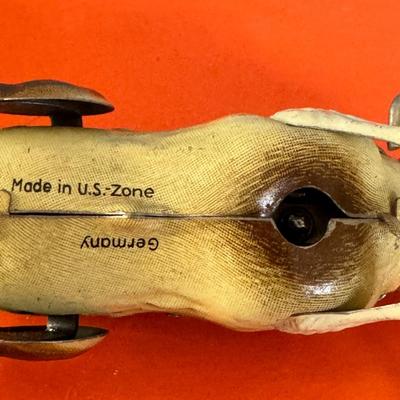
Georg Köhler Dog with Sticks Dance Figure, a rare tin toy from the 1950s. It features a jumping mechanism with a clockwork drive. The toy is approximately 75 mm long. Georg Köhler founded a game and metal goods factory in Nuremberg, Germany, in 1932, and the trademark became the letters GKN intertwined in a triangle. Initially, the company produced lithographed animal figures with clockwork mechanisms, including a frog and a bird. Later, they introduced other tin toy figures, such as the dog with a stick (as seen in the image), ducks, and squirrels. These toys were characterized by their realistic movements. This particular toy was made in the U.S. Zone of Germany, likely between 1946 and 1953. Another example of a GKN Köhler toy is a "Puss in Boots" tin litho windup from the 1940s. 355 / 1369 -
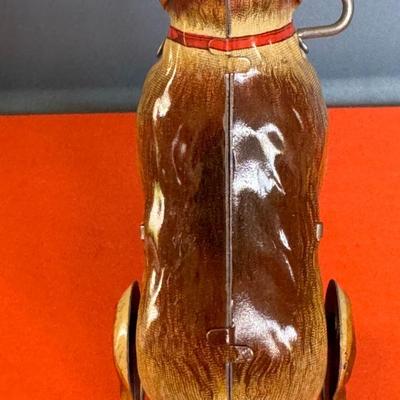
Georg Köhler Dog with Sticks Dance Figure, a rare tin toy from the 1950s. It features a jumping mechanism with a clockwork drive. The toy is approximately 75 mm long. Georg Köhler founded a game and metal goods factory in Nuremberg, Germany, in 1932, and the trademark became the letters GKN intertwined in a triangle. Initially, the company produced lithographed animal figures with clockwork mechanisms, including a frog and a bird. Later, they introduced other tin toy figures, such as the dog with a stick (as seen in the image), ducks, and squirrels. These toys were characterized by their realistic movements. This particular toy was made in the U.S. Zone of Germany, likely between 1946 and 1953. Another example of a GKN Köhler toy is a "Puss in Boots" tin litho windup from the 1940s. 356 / 1369 -
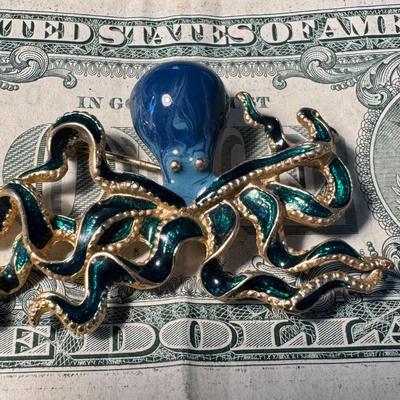
vintage enamel octopus brooch, specifically identified as a piece from the Museum of Fine Arts (MFA) Boston collection. Key details about this brooch: Design: It features a vibrant, sculpted octopus design with a blue body and green enamel on its tentacles, accented with gold-toned metal. Origin: The brooch is signed and associated with the Museum of Fine Arts, Boston. Material: It is categorized as enamel costume jewelry, made with high-quality gold-tone metal and enamel. 357 / 1369 -
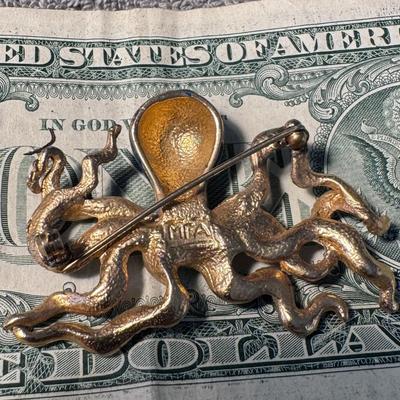
vintage enamel octopus brooch, specifically identified as a piece from the Museum of Fine Arts (MFA) Boston collection. Key details about this brooch: Design: It features a vibrant, sculpted octopus design with a blue body and green enamel on its tentacles, accented with gold-toned metal. Origin: The brooch is signed and associated with the Museum of Fine Arts, Boston. Material: It is categorized as enamel costume jewelry, made with high-quality gold-tone metal and enamel. 358 / 1369 -
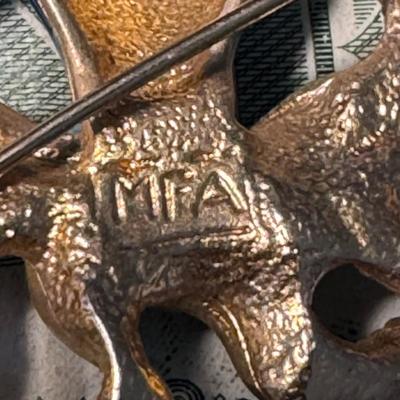
vintage enamel octopus brooch, specifically identified as a piece from the Museum of Fine Arts (MFA) Boston collection. Key details about this brooch: Design: It features a vibrant, sculpted octopus design with a blue body and green enamel on its tentacles, accented with gold-toned metal. Origin: The brooch is signed and associated with the Museum of Fine Arts, Boston. Material: It is categorized as enamel costume jewelry, made with high-quality gold-tone metal and enamel. 359 / 1369 -
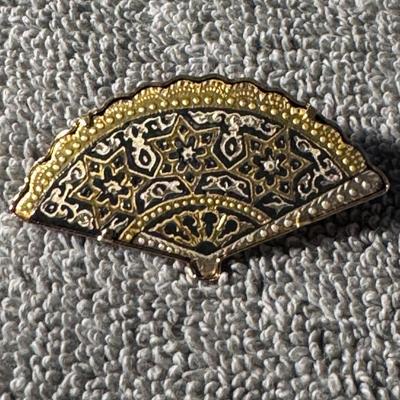
The object in the image is a vintage Damascene fan brooch, likely originating from Spain or Japan. Here's more information about this type of item: Damascene Artistry: Damascene jewelry features intricate designs created by inlaying precious metals (like gold) into a contrasting base metal (often steel or iron), resulting in striking patterns against a dark background. Design and Materials: This specific brooch is fan-shaped with detailed gold patterns set against a black enamel or oxidized steel background, embodying the characteristic style of Damascene work. Origin: While Damascus is the historical origin of the technique, Toledo, Spain, became a prominent center for Damascene production, especially for jewelry, and similar styles were also produced in places like Japan. 360 / 1369 -
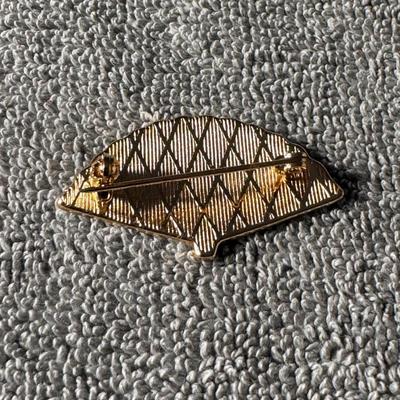
The object in the image is a vintage Damascene fan brooch, likely originating from Spain or Japan. Here's more information about this type of item: Damascene Artistry: Damascene jewelry features intricate designs created by inlaying precious metals (like gold) into a contrasting base metal (often steel or iron), resulting in striking patterns against a dark background. Design and Materials: This specific brooch is fan-shaped with detailed gold patterns set against a black enamel or oxidized steel background, embodying the characteristic style of Damascene work. Origin: While Damascus is the historical origin of the technique, Toledo, Spain, became a prominent center for Damascene production, especially for jewelry, and similar styles were also produced in places like Japan. 361 / 1369 -
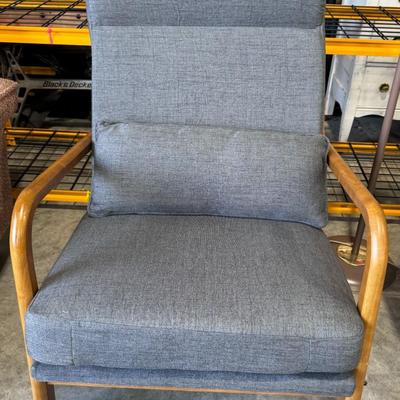
Clean new chair with great styling 362 / 1369 -
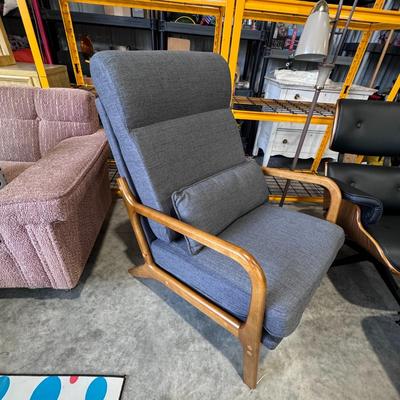
Clean new chair with great styling 363 / 1369 -
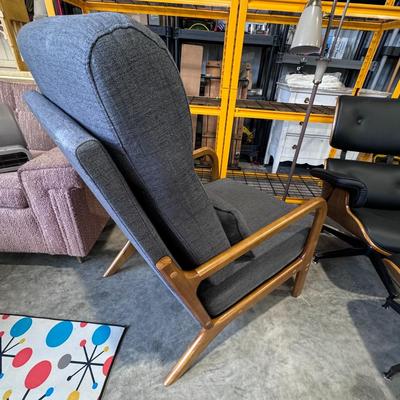
Clean new chair with great styling 364 / 1369 -
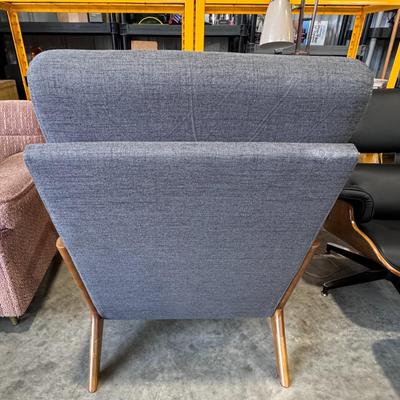
Clean new chair with great styling 365 / 1369 -
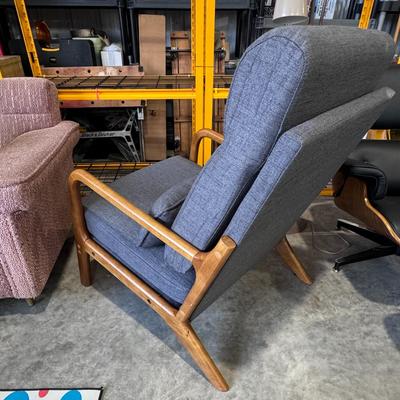
Clean new chair with great styling 366 / 1369 -
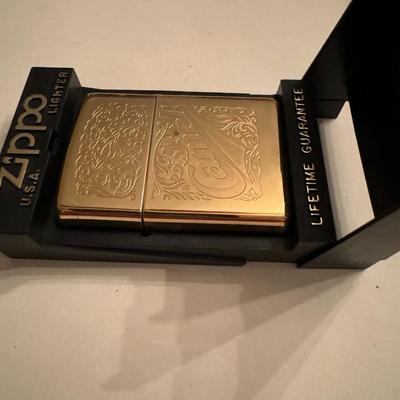
Zippo Camel lighter. It's a vintage Zippo from 1995 featuring a detailed design, described as "22kt Luster Etch". This design process involves double etching into the brass lighter, with chrome applied to create a multi-dimensional effect. Some of the design elements are chromed out for a more striking appearance. The specific design on this lighter includes scrollwork and the "Camel" logo. This particular model is a vintage 1995 Camel 22kt Luster Etch Zippo, and it's described as new and unfired 375 / 1369 -
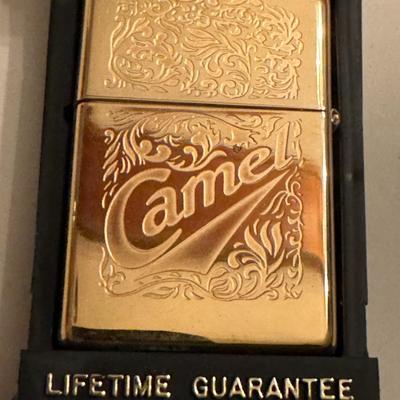
Zippo Camel lighter. It's a vintage Zippo from 1995 featuring a detailed design, described as "22kt Luster Etch". This design process involves double etching into the brass lighter, with chrome applied to create a multi-dimensional effect. Some of the design elements are chromed out for a more striking appearance. The specific design on this lighter includes scrollwork and the "Camel" logo. This particular model is a vintage 1995 Camel 22kt Luster Etch Zippo, and it's described as new and unfired 376 / 1369 -
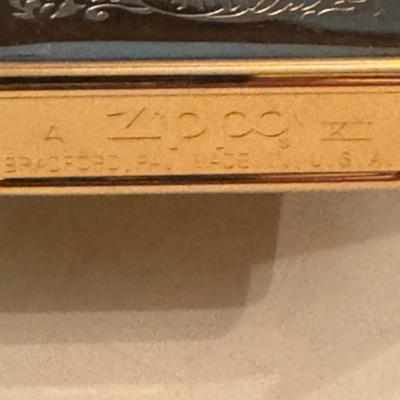
Zippo Camel lighter. It's a vintage Zippo from 1995 featuring a detailed design, described as "22kt Luster Etch". This design process involves double etching into the brass lighter, with chrome applied to create a multi-dimensional effect. Some of the design elements are chromed out for a more striking appearance. The specific design on this lighter includes scrollwork and the "Camel" logo. This particular model is a vintage 1995 Camel 22kt Luster Etch Zippo, and it's described as new and unfired 377 / 1369 -
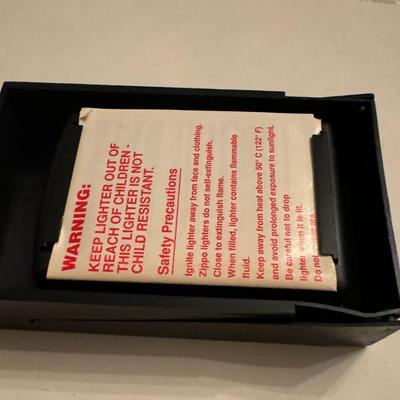
Zippo Camel lighter. It's a vintage Zippo from 1995 featuring a detailed design, described as "22kt Luster Etch". This design process involves double etching into the brass lighter, with chrome applied to create a multi-dimensional effect. Some of the design elements are chromed out for a more striking appearance. The specific design on this lighter includes scrollwork and the "Camel" logo. This particular model is a vintage 1995 Camel 22kt Luster Etch Zippo, and it's described as new and unfired 378 / 1369 -
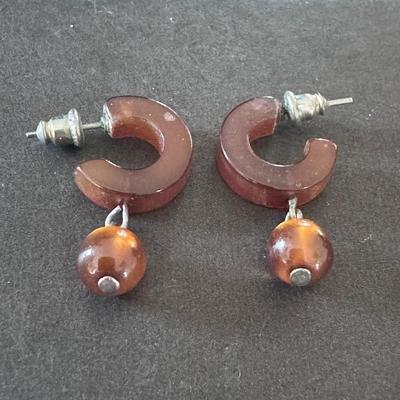
Chloe Hoops in Amber, a style of earring featuring chunky, C-shaped hoops in a warm, amber color, often with a marbled or semi-transparent finish. Key features and details: Design: They boast a modern, chunky silhouette with an open hoop style, crafted from durable, lightweight resin. Material: Made from resin with hypoallergenic stainless steel posts, making them suitable for sensitive ears. Color: The specific pair in the image is in an "Amber" hue, which typically refers to a warm, brownish-orange color that can be translucent or marbled. 379 / 1369 -
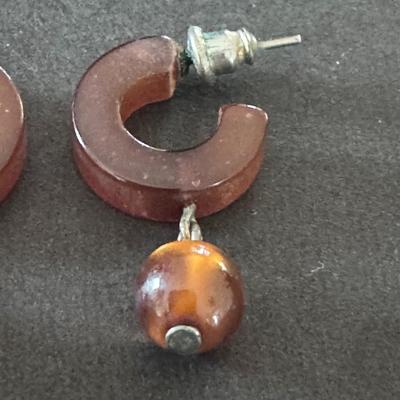
Chloe Hoops in Amber, a style of earring featuring chunky, C-shaped hoops in a warm, amber color, often with a marbled or semi-transparent finish. Key features and details: Design: They boast a modern, chunky silhouette with an open hoop style, crafted from durable, lightweight resin. Material: Made from resin with hypoallergenic stainless steel posts, making them suitable for sensitive ears. Color: The specific pair in the image is in an "Amber" hue, which typically refers to a warm, brownish-orange color that can be translucent or marbled. 380 / 1369 -
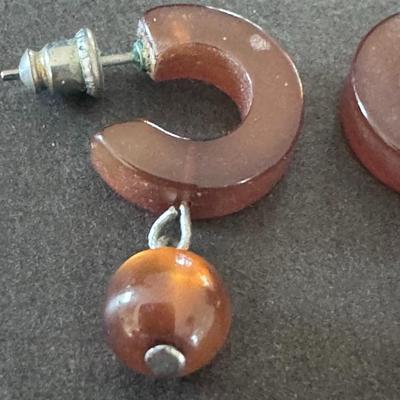
Chloe Hoops in Amber, a style of earring featuring chunky, C-shaped hoops in a warm, amber color, often with a marbled or semi-transparent finish. Key features and details: Design: They boast a modern, chunky silhouette with an open hoop style, crafted from durable, lightweight resin. Material: Made from resin with hypoallergenic stainless steel posts, making them suitable for sensitive ears. Color: The specific pair in the image is in an "Amber" hue, which typically refers to a warm, brownish-orange color that can be translucent or marbled. 381 / 1369 -
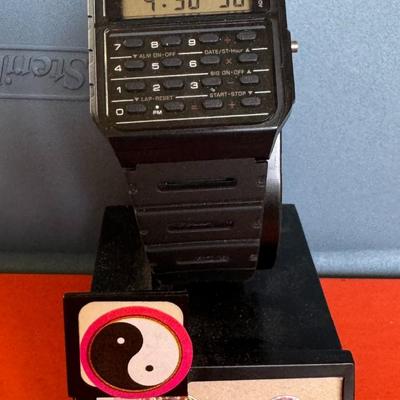
Casio CA-53W calculator watch. The watch has a digital display. It is known for its calculator function and retro style. About the Casio CA-53W: Design: Rectangular resin case and band, black in color with a grey and black dial. It has a unique keypad on the front for the calculator function. Features: Includes an 8-digit calculator, a 1/100-second stopwatch, daily alarm, dual time, and a full auto-calendar. It is water-resistant, making it suitable for everyday wear like hand washing or rain. Legacy: Famous for its appearance in the Back to the Future films. It's a popular choice for those who appreciate vintage and retro watches. Customer Opinions: Customers generally find the watch to be reliable, functional, and a good value for money. The calculator function is considered useful for quick calculations. The small buttons are sometimes mentioned as being difficult to press. The watch's nostalgic design and affordable price are highlighted as positive aspects. Some users have expressed concerns about the legibility of the inverted LCD display in certain lighting conditions. 382 / 1369 -
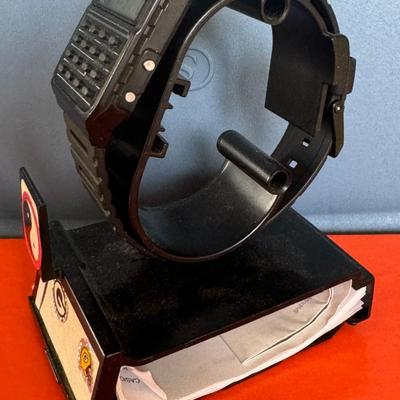
Casio CA-53W calculator watch. The watch has a digital display. It is known for its calculator function and retro style. About the Casio CA-53W: Design: Rectangular resin case and band, black in color with a grey and black dial. It has a unique keypad on the front for the calculator function. Features: Includes an 8-digit calculator, a 1/100-second stopwatch, daily alarm, dual time, and a full auto-calendar. It is water-resistant, making it suitable for everyday wear like hand washing or rain. Legacy: Famous for its appearance in the Back to the Future films. It's a popular choice for those who appreciate vintage and retro watches. Customer Opinions: Customers generally find the watch to be reliable, functional, and a good value for money. The calculator function is considered useful for quick calculations. The small buttons are sometimes mentioned as being difficult to press. The watch's nostalgic design and affordable price are highlighted as positive aspects. Some users have expressed concerns about the legibility of the inverted LCD display in certain lighting conditions. 383 / 1369 -
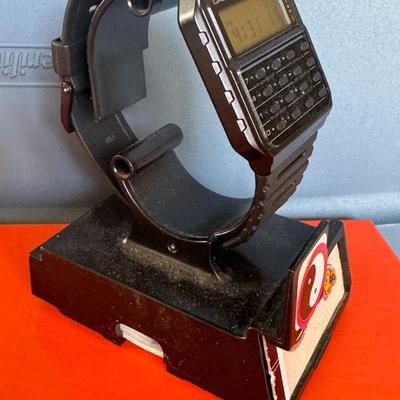
Casio CA-53W calculator watch. The watch has a digital display. It is known for its calculator function and retro style. About the Casio CA-53W: Design: Rectangular resin case and band, black in color with a grey and black dial. It has a unique keypad on the front for the calculator function. Features: Includes an 8-digit calculator, a 1/100-second stopwatch, daily alarm, dual time, and a full auto-calendar. It is water-resistant, making it suitable for everyday wear like hand washing or rain. Legacy: Famous for its appearance in the Back to the Future films. It's a popular choice for those who appreciate vintage and retro watches. Customer Opinions: Customers generally find the watch to be reliable, functional, and a good value for money. The calculator function is considered useful for quick calculations. The small buttons are sometimes mentioned as being difficult to press. The watch's nostalgic design and affordable price are highlighted as positive aspects. Some users have expressed concerns about the legibility of the inverted LCD display in certain lighting conditions. 384 / 1369 -
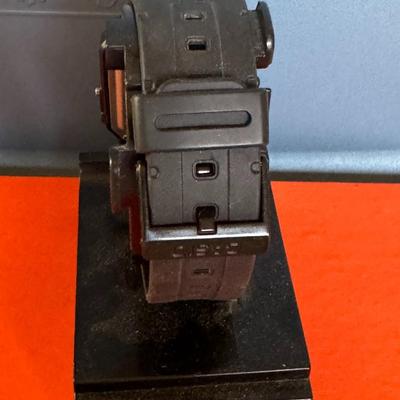
Casio CA-53W calculator watch. The watch has a digital display. It is known for its calculator function and retro style. About the Casio CA-53W: Design: Rectangular resin case and band, black in color with a grey and black dial. It has a unique keypad on the front for the calculator function. Features: Includes an 8-digit calculator, a 1/100-second stopwatch, daily alarm, dual time, and a full auto-calendar. It is water-resistant, making it suitable for everyday wear like hand washing or rain. Legacy: Famous for its appearance in the Back to the Future films. It's a popular choice for those who appreciate vintage and retro watches. Customer Opinions: Customers generally find the watch to be reliable, functional, and a good value for money. The calculator function is considered useful for quick calculations. The small buttons are sometimes mentioned as being difficult to press. The watch's nostalgic design and affordable price are highlighted as positive aspects. Some users have expressed concerns about the legibility of the inverted LCD display in certain lighting conditions. 385 / 1369 -
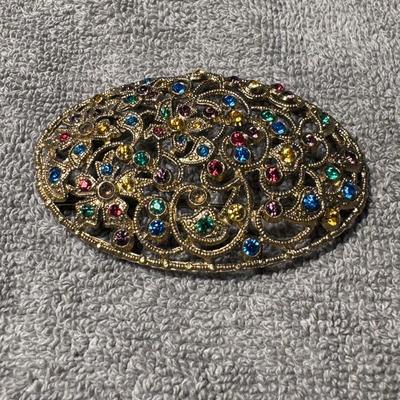
Vintage Neiger Czech Turquoise Glass Snake Eye Cabochon Jewel Brooch Pin. Details about this type of brooch: Origin: It's believed to be a piece by the Neiger Brothers, known for their Czech jewelry from the Art Deco era, particularly the 1920s-1930s. Materials: These brooches often feature turquoise glass cabochons and may include other elements like enamel paint, filigree brass settings, and other glass cabochons. Design: Neiger pieces are recognizable by their distinct Art Deco style, often incorporating motifs like scarabs, snakes, or floral designs within intricate metalwork. Collectibility: Vintage Neiger Czech jewelry, especially well-preserved pieces, is considered collectible due to its historical significance and unique artistry 386 / 1369 -
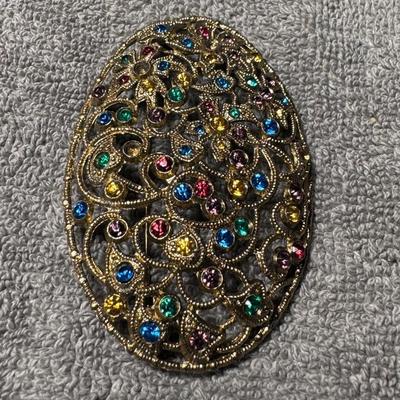
Vintage Neiger Czech Turquoise Glass Snake Eye Cabochon Jewel Brooch Pin. Details about this type of brooch: Origin: It's believed to be a piece by the Neiger Brothers, known for their Czech jewelry from the Art Deco era, particularly the 1920s-1930s. Materials: These brooches often feature turquoise glass cabochons and may include other elements like enamel paint, filigree brass settings, and other glass cabochons. Design: Neiger pieces are recognizable by their distinct Art Deco style, often incorporating motifs like scarabs, snakes, or floral designs within intricate metalwork. Collectibility: Vintage Neiger Czech jewelry, especially well-preserved pieces, is considered collectible due to its historical significance and unique artistry 387 / 1369 -
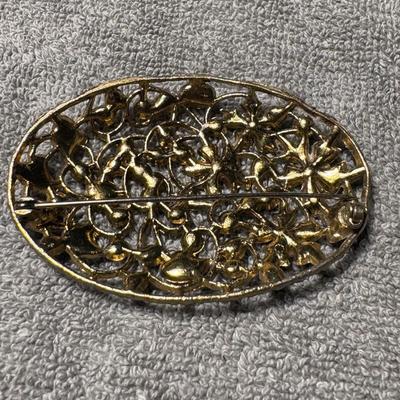
Vintage Neiger Czech Turquoise Glass Snake Eye Cabochon Jewel Brooch Pin. Details about this type of brooch: Origin: It's believed to be a piece by the Neiger Brothers, known for their Czech jewelry from the Art Deco era, particularly the 1920s-1930s. Materials: These brooches often feature turquoise glass cabochons and may include other elements like enamel paint, filigree brass settings, and other glass cabochons. Design: Neiger pieces are recognizable by their distinct Art Deco style, often incorporating motifs like scarabs, snakes, or floral designs within intricate metalwork. Collectibility: Vintage Neiger Czech jewelry, especially well-preserved pieces, is considered collectible due to its historical significance and unique artistry 388 / 1369 -
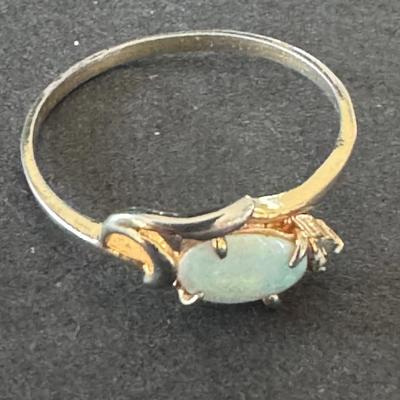
Opal Ring, a vintage piece given its setting and style. Here's more information about it: Gemstone: The central stone is an Opal, known for its unique "play of color," which creates flashes of various hues as light interacts with it. Metal: The ring appears to be made of gold, which is a common and complementary setting for opals, enhancing their natural luster and color intensity. Style: The design suggests it could be a vintage or antique style ring, characterized by intricate detailing around the opal setting, potentially featuring a leaf or floral motif, or a more classic cluster or halo design if there were smaller accent stones (though not clearly visible in this image). Symbolism: Opals are often associated with love, passion, creativity, and good fortune, making them popular choices for engagement or statement rings. 389 / 1369 -
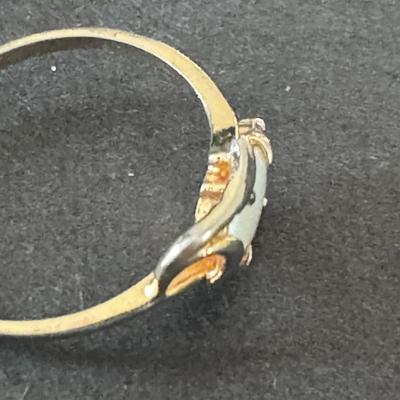
Opal Ring, a vintage piece given its setting and style. Here's more information about it: Gemstone: The central stone is an Opal, known for its unique "play of color," which creates flashes of various hues as light interacts with it. Metal: The ring appears to be made of gold, which is a common and complementary setting for opals, enhancing their natural luster and color intensity. Style: The design suggests it could be a vintage or antique style ring, characterized by intricate detailing around the opal setting, potentially featuring a leaf or floral motif, or a more classic cluster or halo design if there were smaller accent stones (though not clearly visible in this image). Symbolism: Opals are often associated with love, passion, creativity, and good fortune, making them popular choices for engagement or statement rings. 390 / 1369 -
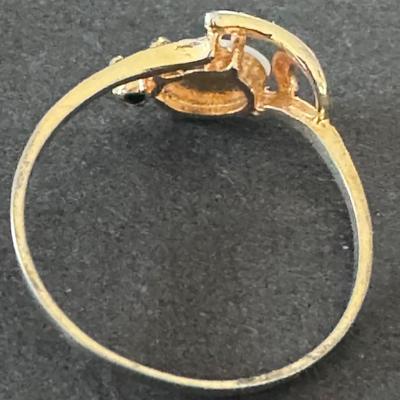
Opal Ring, a vintage piece given its setting and style. Here's more information about it: Gemstone: The central stone is an Opal, known for its unique "play of color," which creates flashes of various hues as light interacts with it. Metal: The ring appears to be made of gold, which is a common and complementary setting for opals, enhancing their natural luster and color intensity. Style: The design suggests it could be a vintage or antique style ring, characterized by intricate detailing around the opal setting, potentially featuring a leaf or floral motif, or a more classic cluster or halo design if there were smaller accent stones (though not clearly visible in this image). Symbolism: Opals are often associated with love, passion, creativity, and good fortune, making them popular choices for engagement or statement rings. 391 / 1369 -
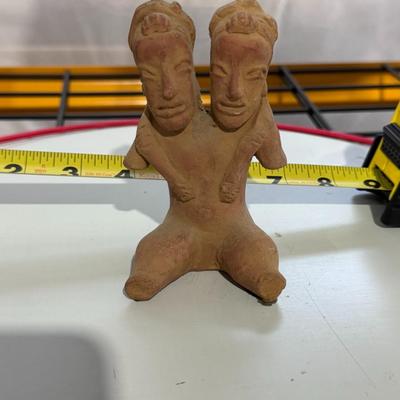
The image shows a vintage terracotta figurine often referred to as "Dual Emotional Distress" or "Portrait of Depression/Anxiety". Here's more information about this figurine: Origin and Purpose: It is a reproduction of an ancient Pre-Columbian style Mexican clay sculpture, specifically in the style of Tlapacoya or Tlatilco figures, known for their expressive portrayals. Pharmaceutical Promotion: This specific figurine was notably used as a promotional item by Schering Pharmaceuticals in the 1970s for their drug Etrafon, which was used to treat depression and anxiety. 392 / 1369 -
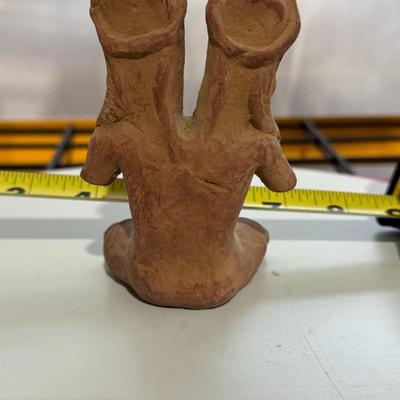
The image shows a vintage terracotta figurine often referred to as "Dual Emotional Distress" or "Portrait of Depression/Anxiety". Here's more information about this figurine: Origin and Purpose: It is a reproduction of an ancient Pre-Columbian style Mexican clay sculpture, specifically in the style of Tlapacoya or Tlatilco figures, known for their expressive portrayals. Pharmaceutical Promotion: This specific figurine was notably used as a promotional item by Schering Pharmaceuticals in the 1970s for their drug Etrafon, which was used to treat depression and anxiety. 393 / 1369 -
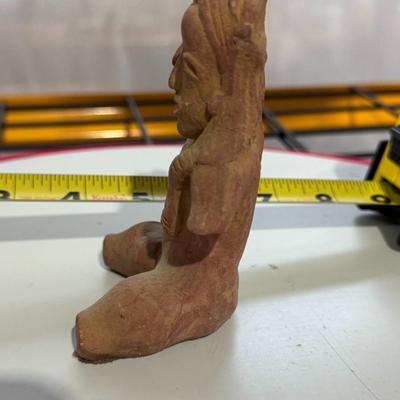
The image shows a vintage terracotta figurine often referred to as "Dual Emotional Distress" or "Portrait of Depression/Anxiety". Here's more information about this figurine: Origin and Purpose: It is a reproduction of an ancient Pre-Columbian style Mexican clay sculpture, specifically in the style of Tlapacoya or Tlatilco figures, known for their expressive portrayals. Pharmaceutical Promotion: This specific figurine was notably used as a promotional item by Schering Pharmaceuticals in the 1970s for their drug Etrafon, which was used to treat depression and anxiety. 394 / 1369 -
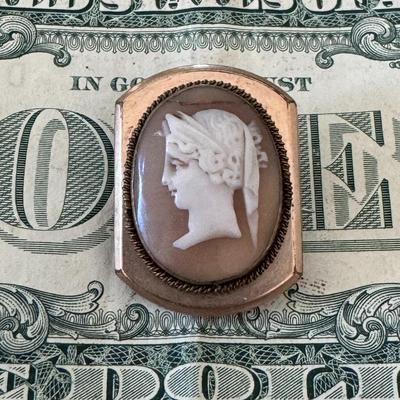
cameo brooch, a type of jewelry featuring a raised relief carving, most commonly depicting a profile of a face, as seen in your image. Here's more information about your cameo brooch: What is a Cameo? Cameos are crafted from materials like shell, stone, coral, or even lava, where the design is carved in relief to stand out from the background layer. Shell cameos, often made from conch shells, are very popular. Identification & Authenticity: To assess if your cameo is authentic: Material: Authentic cameos are usually made from natural materials and won't feel like lightweight plastic or resin. Transparency: If it's a shell or gemstone cameo, holding it to the light might reveal some transparency or the outline of the design from the back. Carving Details: Hand-carved cameos often show fine details and potential faint tool marks when examined closely, unlike the uniform appearance of mass-produced imitations. 397 / 1369 -
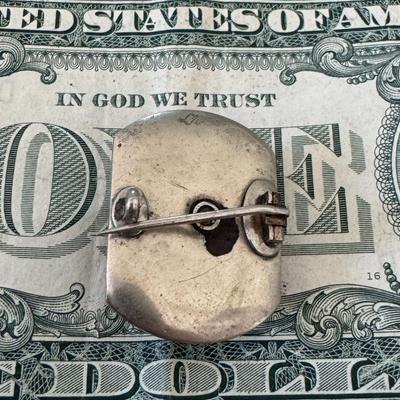
cameo brooch, a type of jewelry featuring a raised relief carving, most commonly depicting a profile of a face, as seen in your image. Here's more information about your cameo brooch: What is a Cameo? Cameos are crafted from materials like shell, stone, coral, or even lava, where the design is carved in relief to stand out from the background layer. Shell cameos, often made from conch shells, are very popular. Identification & Authenticity: To assess if your cameo is authentic: Material: Authentic cameos are usually made from natural materials and won't feel like lightweight plastic or resin. Transparency: If it's a shell or gemstone cameo, holding it to the light might reveal some transparency or the outline of the design from the back. Carving Details: Hand-carved cameos often show fine details and potential faint tool marks when examined closely, unlike the uniform appearance of mass-produced imitations. 398 / 1369 -
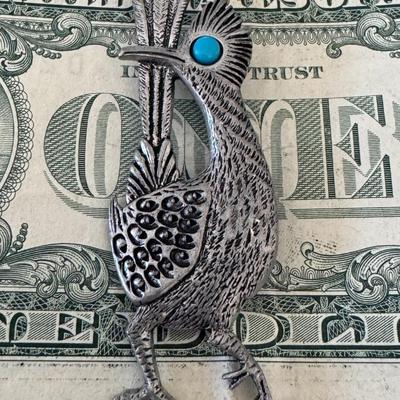
Vintage J. Ritter Roadrunner Brooch with a faux turquoise eye. Here's some information about this item: Maker: The brooch is a piece by J. Ritter, a recognized name in vintage costume jewelry known for their detailed designs. Design: It features a roadrunner bird in a silver-tone finish, with a prominent faux turquoise cabochon serving as the eye, embodying a classic mid-century aesthetic often associated with Southwestern styles. Material: The brooch is made of a silver-tone metal and features a faux, or imitation, turquoise stone for the eye. Collectibility: J. Ritter roadrunner brooches are considered collectible vintage jewelry pieces, particularly appealing to enthusiasts of unique animal-themed accessories. 399 / 1369 -

Vintage J. Ritter Roadrunner Brooch with a faux turquoise eye. Here's some information about this item: Maker: The brooch is a piece by J. Ritter, a recognized name in vintage costume jewelry known for their detailed designs. Design: It features a roadrunner bird in a silver-tone finish, with a prominent faux turquoise cabochon serving as the eye, embodying a classic mid-century aesthetic often associated with Southwestern styles. Material: The brooch is made of a silver-tone metal and features a faux, or imitation, turquoise stone for the eye. Collectibility: J. Ritter roadrunner brooches are considered collectible vintage jewelry pieces, particularly appealing to enthusiasts of unique animal-themed accessories. 400 / 1369
Photos 301 - 400 of 1369
Per page:
